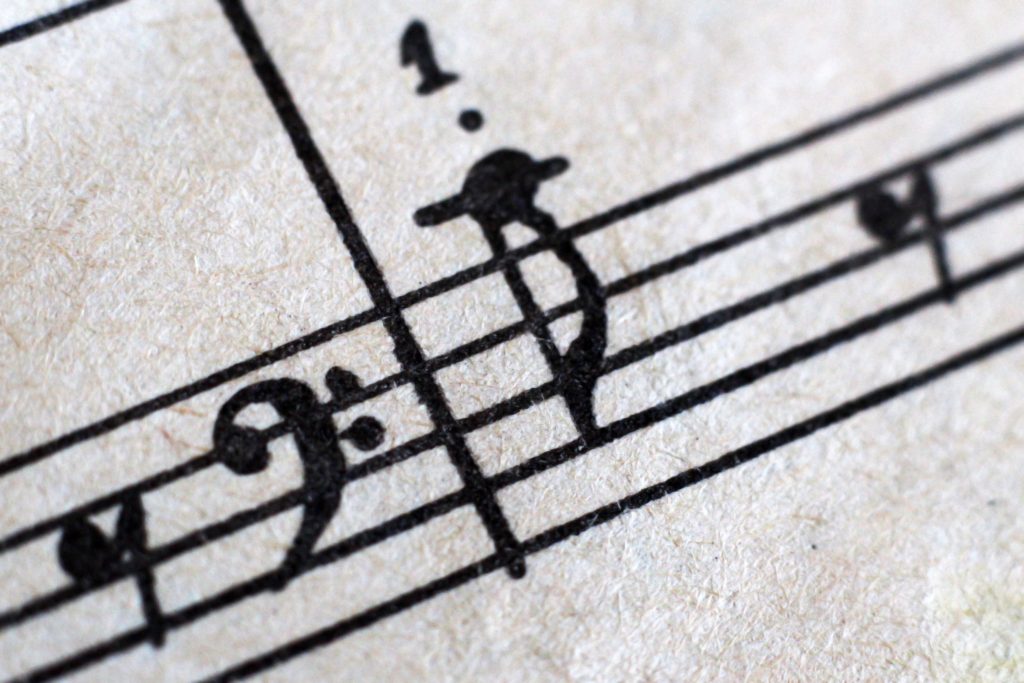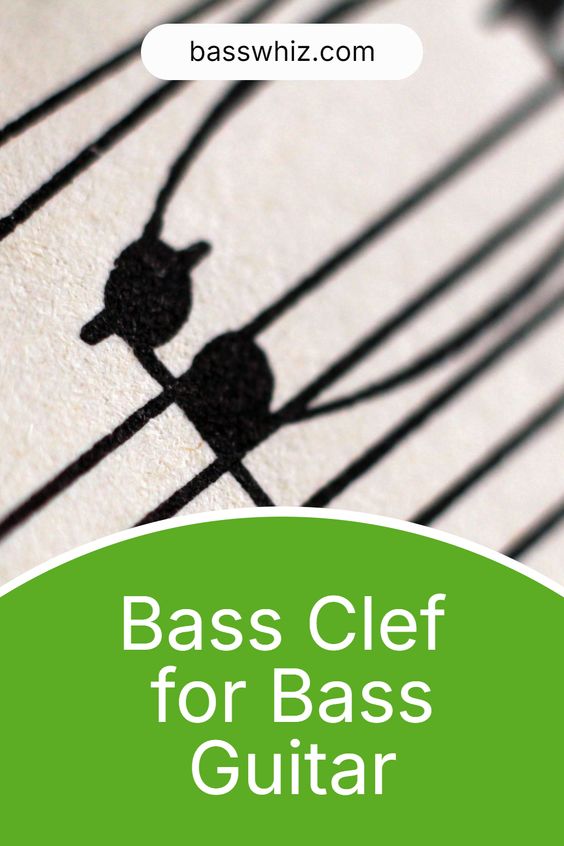Bass Clef for Bass Guitar: How to Read
What is the Bass Clef and Why It Matters for Bassists
If you have been primarily been playing by ear like me or using tabs, you might be wondering, “Do I really need to learn to read bass clef for bass guitar?” The short answer is: absolutely! Learning to read the bass clef opened up a world of possibilities, allowing me to communicate musically on a deeper level, play a broader range of music, and truly understand the instrument in ways that tabs alone simply can’t provide.
Understanding the Basics of Bass Clef for Bass Guitar
What is the Bass Clef?
The bass clef, also known as the F clef, is a symbol that designates the pitch of notes below middle C. For bass guitarists, it’s crucial because it lays out the lower-pitched notes, which are the bread and butter of what we do. Unlike the treble clef used for higher-pitched instruments, the bass clef is a staple for instruments like the bass guitar, double bass, and tuba.
Why Do Bass Guitarists Need to Read the Bass Clef?
While tabs are great for quick learning, understanding the bass clef allows you to read traditional sheet music and improves your musical literacy. Whether you’re playing in an orchestra, band, or solo, being able to read the bass clef gives you the flexibility to perform a wide variety of music, from classical to jazz and everything in between.
The Structure of the Bass Clef
The Lines and Spaces of the Bass Clef
When you look at the bass clef, you’ll see five lines and four spaces. Each line and space represents a different note. Memorizing these notes is the first step toward reading music fluently.
Line Notes in the Bass Clef (G, B, D, F, A)
The notes on the lines from bottom to top are G, B, D, F, and A. A great mnemonic to remember these is “Good Boys Do Fine Always”. Every time you see a note on one of the lines, just think back to this phrase, and you’ll instantly know which note to play.
Space Notes in the Bass Clef (A, C, E, G)
The spaces, on the other hand, represent the notes A, C, E, and G. The handy mnemonic “All Cows Eat Grass” helps bassists quickly recall the notes in the spaces.
Why Reading the Bass Clef is Essential for Bassists
Tab vs. Standard Notation: The Key Differences
Tabs have their place, especially when you’re learning a song quickly, but they lack the depth and precision of standard notation. While tabs tell you which fret to play, they don’t provide information about rhythm, timing, or dynamics. Standard notation, on the other hand, gives you all this information and more.
The Advantages of Learning to Read Music
Reading music allows you to play any piece, from classical to contemporary, without needing a tab. Plus, it makes you a more versatile musician. Being able to communicate with other musicians through sheet music is a powerful skill that opens up endless opportunities.
How to Read the Bass Clef for Bass Guitar
Mnemonics for Memorizing Bass Clef Notes
If you’re just starting out with reading music, mnemonics are your new best friend. These memory aids make it easy to recall which notes correspond to the lines and spaces on the staff.
Good Boys Do Fine Always for Line Notes
To memorize the notes on the lines of the bass clef (G, B, D, F, A), simply remember: Good Boys Do Fine Always. Each word stands for a note on the staff, from the bottom line to the top.
All Cows Eat Grass for Space Notes
For the spaces, the mnemonic All Cows Eat Grass works wonders. It gives you a quick reference for A, C, E, and G, which are the notes found in the spaces of the bass clef.

Relating Bass Clef Notes to the Bass Guitar
Connecting the Notes on the Bass Clef to the Fretboard
Once you’ve memorized the notes on the bass clef, the next step is relating them to your bass guitar’s fretboard. For example, the note G on the bottom line of the bass clef corresponds to the open G string on your bass. Likewise, the note A in the space corresponds to the second fret of the G string.
How the Notes Map to the Strings
It helps to visualize the fretboard and how each string corresponds to the notes on the bass clef. Practice playing the notes on the bass clef and matching them with their positions on your bass guitar, starting with the open strings (E, A, D, G).
Identifying Common Bass Patterns and Scales Using the Bass Clef
One benefit of learning to read the bass clef is that it helps you recognize common patterns like scales and arpeggios. Knowing how to identify these on sheet music can greatly improve your improvisation and songwriting skills.
Practical Tips for Bass Guitarists Learning the Bass Clef
Start Simple: Practice with Basic Sheet Music
If you’re new to reading music, start with simple sheet music. Focus on playing one note at a time, and don’t worry if you have to look up the notes frequently. The more you practice, the more natural it becomes.
Use Sight-Reading Exercises
Sight-reading is one of the best ways to get comfortable with the bass clef. There are many online resources and books designed specifically for bassists who want to improve their sight-reading skills.
Practice with Bass Clef Flashcards and Apps
Flashcards are a great tool for drilling the notes on the bass clef. Apps like Tenuto and Music Tutor also provide interactive ways to practice reading bass clef notes while relating them to your bass guitar.
Advanced Techniques for Reading Bass Clef
Reading Multiple Octaves on the Bass Clef
As you advance, you’ll encounter notes across different octaves. Learning to read these on the bass clef and translating them to the fretboard is a crucial skill. Practice scales and arpeggios in different octaves to become more comfortable with this.
Playing and Reading in Different Keys
Being able to read music in various keys is essential for any bassist. This involves not only understanding the bass clef but also recognizing sharps, flats, and key signatures. Start by practicing scales in different keys while reading from sheet music.

Developing Fluency in Reading Bass Clef
Daily Sight-Reading Drills
To truly master the bass clef, you need to make sight-reading a daily habit. Spend just 10-15 minutes a day reading new sheet music, and over time, you’ll notice significant improvements in your fluency.
Using Bass Clef to Understand Harmonic Structures
Reading the bass clef also helps you understand harmonic structures in music. You’ll be able to see how the bass line interacts with chords and melodies, which is essential for bassists who play in bands or compose music.
Conclusion
Learning to read the bass clef for bass guitar might seem like a daunting task, but trust me, it’s a game-changer for your musical journey. Not only will you be able to explore a wider variety of music, but you’ll also deepen your understanding of the bass guitar itself. With the help of mnemonics like “Good Boys Do Fine Always” and “All Cows Eat Grass,” you’ll find it much easier to memorize the notes on the bass clef. The key is consistent practice—start slow, use sight-reading exercises, and gradually build your skills. Before you know it, reading music will become second nature, and you’ll be able to play anything from jazz standards to classical masterpieces.
FAQs
- Why is reading bass clef important for bass guitarists?
Learning to read the bass clef allows you to read sheet music, giving you access to a broader range of musical pieces and helping you understand the structure of music better. - Can I rely only on tabs, or do I need to learn the bass clef?
While tabs are useful for learning songs quickly, reading the bass clef will help you become a more versatile and knowledgeable musician. - How long does it take to learn to read the bass clef?
With consistent practice, most players can start reading basic music in a few weeks, though becoming fluent may take a few months or more. - Are there apps to help with reading the bass clef?
Yes, apps like Tenuto and Music Tutor offer interactive exercises to help you practice reading the bass clef and connecting the notes to your bass guitar. - What is the best way to start learning the bass clef?
Start with simple sheet music, use mnemonics to memorize the notes, and practice daily with sight-reading exercises to gradually build your proficiency.




